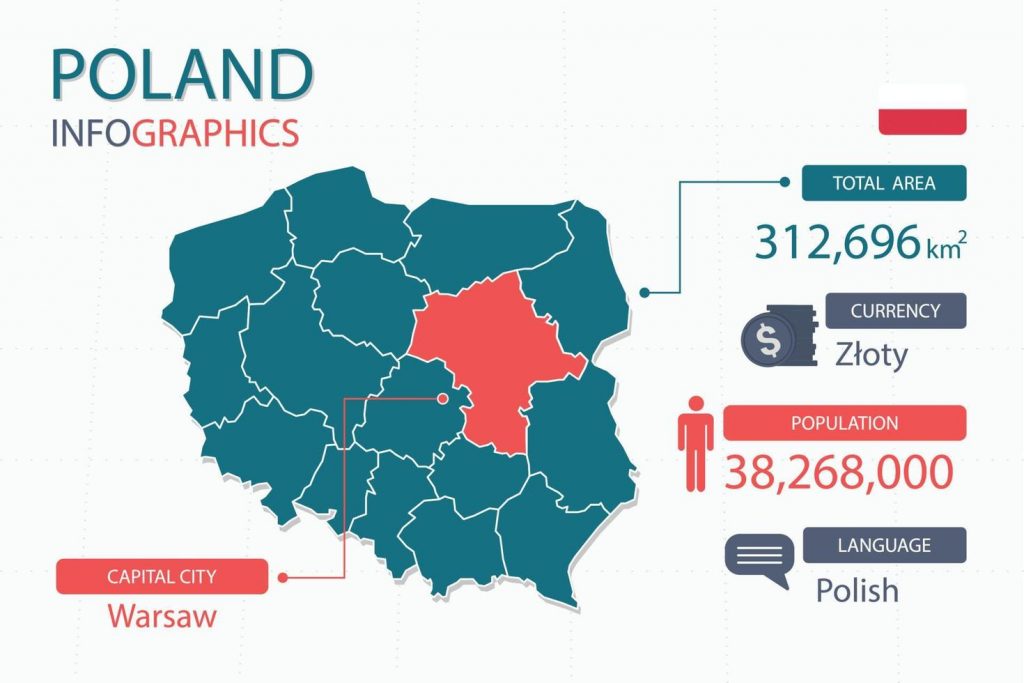The origins of the Polish Language
Polish is a world language much associated with the Poles, the ethnic group native to Poland. It has official status in Poland, holds the status of one of the official languages in the European Union and is a recognized minority language in a number of European countries ranging from the Czech Republic to the Ukraine. With a large Polish diaspora spanning the globe, especially after World War II, it is also spoken in a number of other areas including the Middle East (Israel), South America (Argentina and Brazil), and North America (the United States and Canada).
Characteristics of Polish that might differentiate it from other languages include it’s three gender system, which contains masculine, feminine, and neuter nouns. In addition, Polish also has a case system containing seven cases. Other languages that have case systems include German, Czech, and Russian. While the Polish word order is subject-verb-object, a combination of a case system and gender system allows for extreme flexibility.
VEQTA can provide Certified translation Polish to English and Polish translations from English. We translate to Polish for most subject matters and types of documents. We can provide a translator into Polish who has the necessary background in Polish translations of the types of content you need to translate to Polish.
Polish falls under the West Slavic subdivision of the language family tree. Other languages that fall under this group include Czech and Slovak. In addition, there have been influences on the language from a variety of sources, especially in terms of vocabulary. In its earlier history, Latin, Czech, and Italian contributed a large amount of loan words. Other influences include German, French, Hungarian, and Turkish as well. Most recently, like many other languages, English loanwords have entered the language. Likewise, Polish has also contributed words to other languages, especially in regards to culinary concepts. These words include quark, a type of cheese, gherkin, for a type of cucumber, pierogi, a Polish dumping, and kielbasa, a type of sausage.
The Polish writing system comes from a Latin-based script. It contains the basic Latin set with the omission of Q and X, and the addition of Polish accent marks, to signify sounds that are more unique to the Polish language. It is written from left-to-right, similar to other Latin-based writing systems.

Historically, Polish displayed characteristics of a distinct language in the 10th century, especially as an official Polish state was recognized and also became part of the Papal State. It stems from other Slavic languages. It is considered by some scholars to be the oldest written Slavic language that has a long tradition of literature and prestige. Between the 16th and 18th centuries, it was used as a lingua franca in Central and Eastern Europe, due to the sociocultural sway that the Polish-Lithuanian Commonwealth held at the time. The time periods of polish can be divided into Old Polish, Middle Polish, and Modern Polish, as described by historical linguists.
Old Polish was the variety spoken between the 9th and 16th centuries. At this time, the Latin alphabet had already been adopted. It was first used to transcribe religious texts that were originally in Latin, so that literate Polish speakers can read them. However, it seemed ill-fitted to transcribe certain sounds found in Polish. As a result, there were many attempts at spelling difficult to transcribe words, and a standard spelling did not appear this time. In addition, there had been many attempts to codify Polish and make a grammar. For example, in 1440, a Latin description of Polish spelling was written.
By the time Middle Polish came around in the 16th century, spelling rules and a modified alphabet was proposed by Jan Kochanowski, a famous Polish poet. The alphabet at that time had 48 letters, with letters that do not exist in Modern Polish nowadays. Modern Polish emerged after the 18th century. By this time, a more standard spelling had emerged. In the 19th century, the first Polish dictionary was published, being compromised of six volumes.
However, Polish has historically been a language with many dialects, which were sometimes very different. The language became much more standardized after World War II and after Soviet annexation of a part of Poland, when many Polish citizens moved to the Western area. At this time, a standard emerged. To this day, there are still four or five main dialects, but they are mutually intelligible and have merged with a more Standard Polish. Interestingly, these dialects and their characteristics have continued to survive throughout the Polish speaking diaspora. for example, Polish communities in the United States who still speak the language may use a vocabulary that may sound archaic to more contemporary speakers, as their language reflected the vernacular used during the earlier 20th century and didn’t evolve at the same pace.
Today, Polish is a major language with historical significance, especially for its role in World War II. About 38 million individuals claim it as their first language, and it is the second-language of many others. Today the Polish language is regulated by the Polish Language Council. Despite its regulation though, many English words have entered the language, but in a way that it assimilates with the language.
For a perfect Polish translator or Polish to English translation services get in contact with the VEQTA team today!
VEQTA can provide you with a perfect Polish translator for your Polish translation, English to Polish translation and Polish to english translation for the your targeted locale. Our translations to Polish are created with your target audience in mind to meet your expectations.
If you need to translate Polish – Get in touch today!
A dedicated team of Polish translators who combines Experience, Specialized Subject Matter Expertise with Translation Practices to deliver quality second to none.
Polish Subject Expertise
Polish Translators
Polish Editors
Polish Copywriters
Polish Reviewers
Polish Voice dubbing
Polish Subtitling
Polish Transcription


